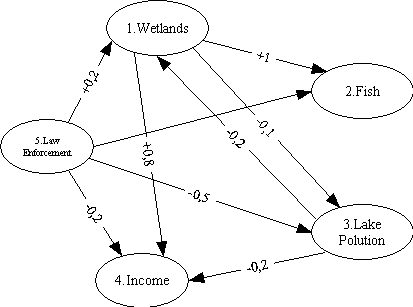A fuzzy cognitive map (FCM) can be understood as a graphical representation of the knowledge about or the perception of a given system. Fuzzy cognitive mapping is a combination of fuzzy logic and cognitive mapping. Cognitive mapping is based on graph theory, which is also the basis of most calculations and indices. A FCM consists of factors (concepts / nodes) which represent the important elements of the mapped system. The directed lines labeled with fuzzy values show the strength of the causal conditions between the factors. A fuzzy cognitive map is a model of system structure.
Using a method originated in neural network approaches, the influence of the factors on each other can be calculated iteratively. Once the network has stabilized, the results show the trends within the system. FCM also offers the possibility to run simulations and calculate outcomes of possible scenarios.
To get better insight take a look at the very simple FCM and its matrix-form below:

Fig. 1: Fuzzy cognitive map taken from Özesmi & Özesmi 2004
Tab. 1: Showing the matrix form and a selection of indices of the FCM in Fig. 1
| Groups Özesmi&Özesmi 2004 | 1. Wetlands | 2. Fish | 3. Lake Pollution | 4. Income | 5. Law Enforcement |
| 1. Wetlands | 0.0 | 1.0 | -0.1 | 0.8 | 0.0 |
| 2. Fish | 0.0 | 0.0 | 0.0 | 0.0 | 0.0 |
| 3. Lake Pollution | -0.2 | 0.0 | 0.0 | -0.2 | 0.0 |
| 4. Income | 0.0 | 0.0 | 0.0 | 0.0 | 0.0 |
| 5. Law Enforcement | 0.2 | 0.5 | -0.5 | -0.2 | 0.0 |
| Outdegree | 1.90 | 0.00 | 0.40 | 0.00 | 1.40 |
| Indegree | 0.40 | 1.50 | 0.60 | 1.20 | 0.00 |
| Centrality | 2.30 | 1.50 | 1.00 | 1.20 | 1.40 |
| Type | Ordinary | Receiver | Ordinary | Receiver | Transmitter |
| Density | Total Nr. Factors | Total Nr. Connections | Nr. Transmitter | Nr. Receiver | Nr. Ordinary |
| 0.36 | 5 | 9 | 1 | 2 | 2 |
References:
Özesmi U, Özesmi SL (2004) Ecological models based on people´s knowledge: a multi
step fuzzy cognitive approach. Ecological Modelling 176:43-64
